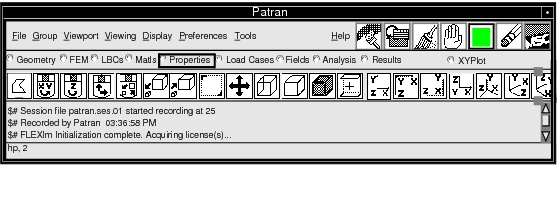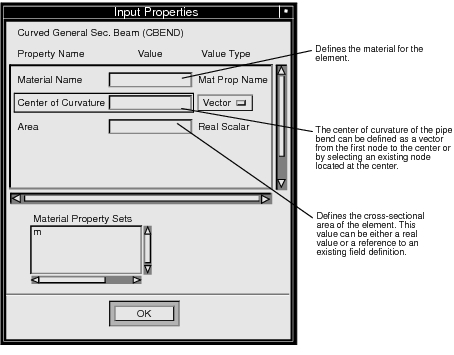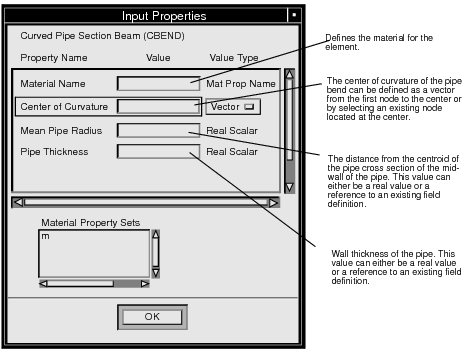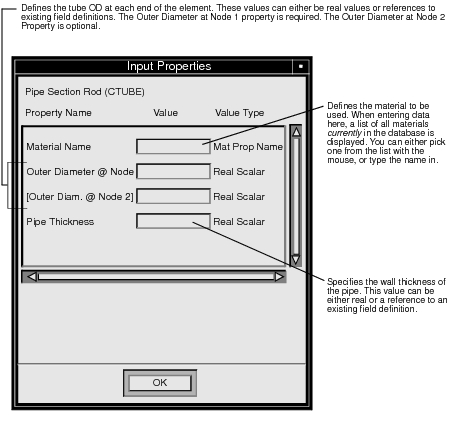XXXXXXXXXXXXXXXXXXXXXXXXXXXXXXXXXXXXXXXXXXXXXXXXXXXXXXXXXXXXXXXXXXXXXXXXXXXXXXXXXXXXXXXXXXXXXXXXXXXXXXXXXXXXXXXXXXXXXXXXXXXXXXXXXXXXXXXXXXXXXXXXXXXXXXXX''"> 3.5 Finite Element Properties
The Element Properties form appears when you select Properties from the main form. There are several option menus available when creating element properties. The selections made on the Element Properties menu will determine which element property form appears, and ultimately, which MD Nastran element will be created.
The following pages give an introduction to the Element Properties form and details of all the element property definitions supported by the Patran MD Nastran Thermal Application Preference.
Element Properties Form
This form appears when you select Element Properties from the main menu. There are
four option menus on this form. Each will determine which MD Nastran element type will be created and which property forms will appear. The individual property forms are documented later in this section. For a full description of this form, see
Element Properties Forms (p. 61) in the Patran Reference Manual.
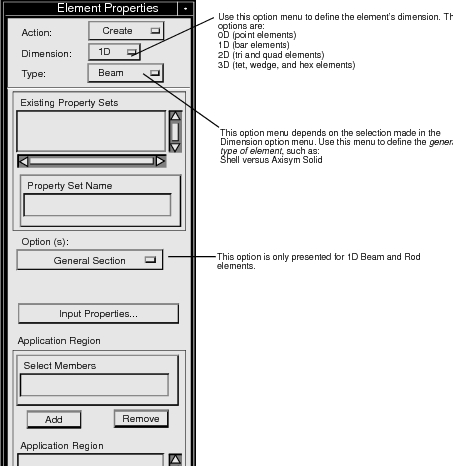
The available element types are described briefly in the table below.
Dimension | Type | Option | Elem Type | Input Data |
0D | | | CELAS1 | Thermal Conductance |
| | CDAMP1 | Thermal Capacitance |
1D | • Beam | | CBAR | Material Name Area |
| CBEND | Material Name Center of Curvature Area |
| CBEND | Material Name Center of Curvature Mean Pipe Radius Pipe Thickness |
| CBEAM | Material Name Cross Sect. Areas |
• Rod | | CROD | Material Name Area |
| CTUBE | Material Name Outer Diameter @ Node [Outer Diam. @ Node 2] Pipe Thickness |
| | CELAS1 | Thermal Conductance |
| | CDAMP1 | Thermal Capacitance |
| | CHBDYP | Material Name Hydraulic Diam. at Node 1 [Hydraulic Diam. at Node 2] |
2D | | | CQUAD4,8 CTRIA3,6 | Material Name [Material Orientation] Thickness |
| | CTRIAX6 | [Material Orientation] Material Name |
3D | | | CHEXA CPENTA CTETRA | Material Name |
Conductors and Grounded Conductors
These elements provide a simple conductance link between either two nodes in the model or a node and a zero temperature heat sink. The only property to be defined is the thermal conductance of the link. This value can either be real or a reference to an existing field definition.
Capacitors and Grounded Capacitors
These elements provide a simple thermal capacitance link between either two nodes in the model or a node and a zero temperature heat sink. The only property to be defined is the thermal capacitance of the link. This value can either be real or a reference to an existing field definition.
Beam and Rod Elements with General Section
These elements provide a simple conductance and capacitance link between two nodes in the model. Heat is conducted only along the length of the element; no heat is transferred across the cross section. The referenced material and cross-sectional area must be defined. Cross-sectional area can be defined either as a real value or as a reference to an existing field definition.
Curved General Section Beam
Curved Pipe Section Beam
Tapered Section Beam
The Tapered Section beam allows different cross-sectional areas at each end of the beam. Both areas are entered in the Cross Sect. Areas databox separated by either spaces or a comma. If only one area is defined, the cross-sectional area is assumed to be constant at that value.
Pipe Section Rod
Flow Tube
This element defines heat transfer based on 1D fluid flow. A material with the Fluid constitutive model defined must be selected. In addition, the diameters of tube at each end must be defined; if only the diameter at node 1 is defined, the tube diameter is assumed to be constant at that value. The value for the diameter may either be real or a reference to an existing field definition. The Flow Tube elements can be referenced in the Loads/BCs application to support several types of forced convection and advection conditions.
2D Shell Elements
These elements provide for conduction and heat capacitance within a planar area. Heat is not transferred through the thickness of the shell.
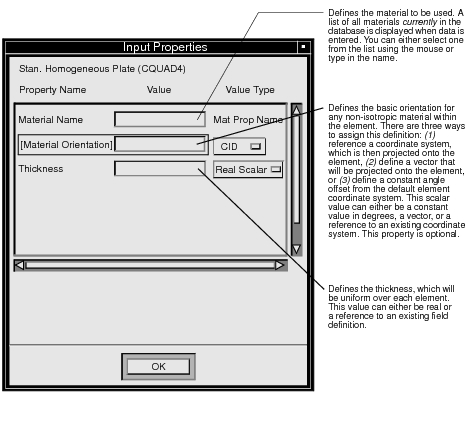
2D Axisymmetric Solid Elements
These elements are used to model heat conduction in a body that is symmetric about a particular coordinate axis. When defining the model with Patran, this axis must be the global z-axis and the radial axis must be the global x-axis (i.e., the elements must lie in the x-z plane). The only element property required is the material. An optional material orientation allows you to define the orientation for any non-isotropic material within the element.
You can specify temperature boundary conditions, initial temperatures, and nodal and volumetric heat loads on the element’s boundaries or interior. You can specify exchange type boundary conditions (convection and radiation) on the boundaries of the geometry.
With Version 68 of MD Nastran, if convection or radiation boundary conditions are applied to 6-node triangular axisymmetric elements, the heat flux results associated with these elements cannot be postprocessed in Patran. To postprocess boundary heat fluxes, the 3-node triangular axisymmetric elements must be used instead.
3D Solid Elements
These elements provide for conduction and heat capacitance within a volume. A material property must be selected to define the thermal conductivity, density, and specific heat.
